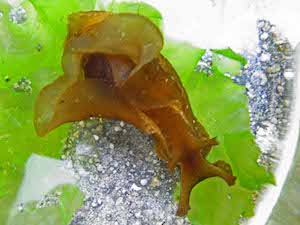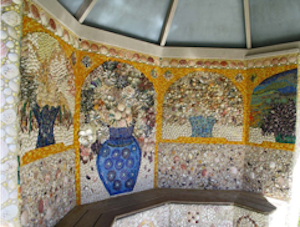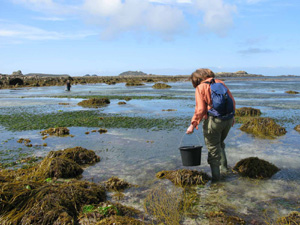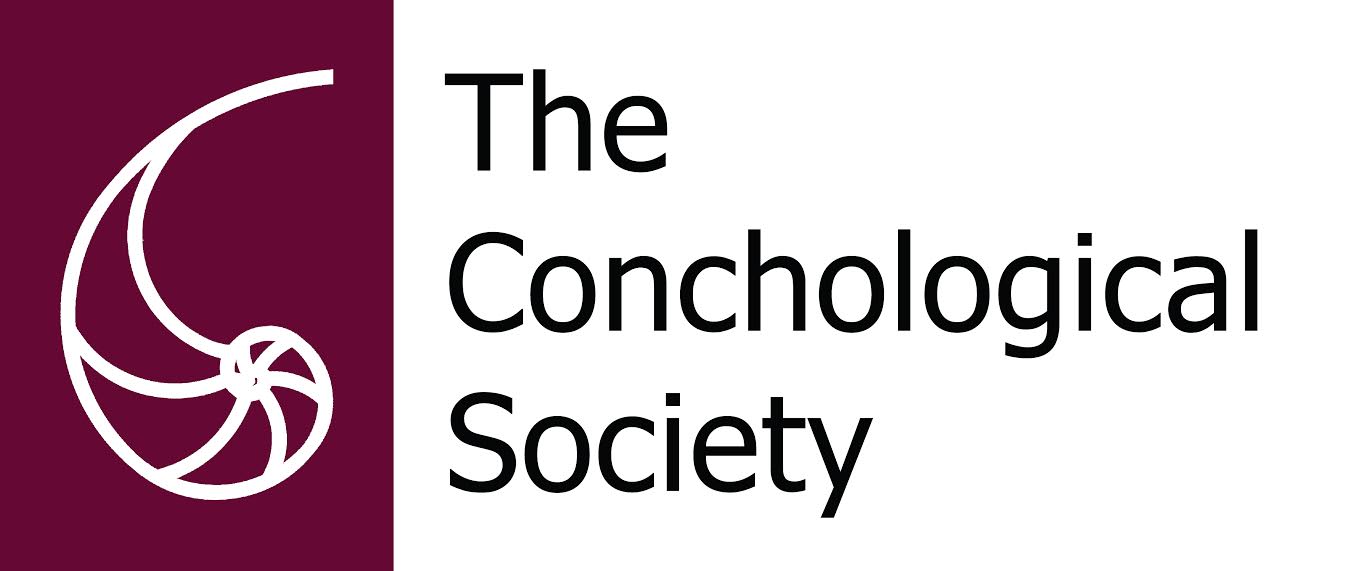We were on a joint meeting on the Isles of Scilly with the Porcupine Marine Natural History Society, about 40 of us altogether (see back cover), enough to fill a chartered boat each day so that we could match our travel timings to the tide times. There were not many conchologists in the group; Celia Pain, John Llewellyn-Jones, Rosemary Hill and myself in a small cottage, Janet Sawyer in the Star Castle, Julia Nunn (also in Porcupine) in a B&B at the far end of the bay, and Shaun and Theo Tamblin under canvas in the garrison. Angie Gall of Porcupine had arranged for laboratory accommodation in the Scillonian Club where microscopes, lamps, specimen dishes, laptops and a projector could be installed; this turned out to be rather crowded, but people were very friendly and were happy to identify seaweeds, crabs, starfish, normal fish, sea spiders and other strange creatures for us.
Normally when you stand on a shoreline and look seawards, what you see is mostly water, but here there are other shorelines in the distance or even close at hand and the place has a different feel from mainland shores.
The day before I arrived, a group from Porcupine surveyed Porth Loo on St Mary’s and found 40 species of molluscs live including the sea slugs Aplysia punctata (figure 1), Berthella plumula, Elysia viridis and Hermaea bifida.

figure 1: Sea Hare, A. punctata, in the laboratory. (Photo: John Llewellyn-Jones)
Our first boat trip on 8 September was to Tresco, where we first had a look at strandlines to the north of Carn Near. I didn’t find this shoreline particularly species rich (though Celia found 10 species of micromolluscs there), so I went along the south coast to look for weed samples that might contain some interesting animals. I also sneaked off for an hour to look round the famous Abbey Gardens, where they have recently constructed a rather splendid shell grotto masquerading as a rain shelter (figure 2).

figure 2: The shell grotto in Tresco Abbey Gardens.
Near Appletree Point, Rosemary and Julia found live Gari costulata, Rosemary found Gafrarium minimum and Julia found live Arcopagia crassa and Chauvetia brunnea. and Theo found Sepia orbignyi. Several people found sea slugs (Archidoris pseudoargus, E. viridis, H. bifida and Polycera quadrilineata).
That evening I spent some time separating the Mollusca from a large range of other creatures which were eventually taken along to the lab in case they were of any interest.
The following day we went to St Agnes and initially spent much time searching the vegetation opposite the Gugh for land molluscs, where four of us found live specimens of Cernuella virgata, Lauria cylindracea, Cornu aspersum, Cepaea nemoralis, Oxychilus alliarius, Cochlicella acuta (figure 3) and Lehmannia valentiana. After walking across the island and consuming a very welcome farmhouse icecream at Troy Town farm, Rosemary and I reached the far shore at Periglis where, dismayed by the size of the boulders and how far it was between us and the shore, we headed towards an area where we saw some fishing boats, and worked that. Many of the Porcupine group could be seen on Burnt Island in the distance; Julia was over there and found three live Turbonilla lactea, which she was rather pleased about, and vaious Porcupine members found the sea slugs A. pseudoargus and E. viridis.

figure 3: Two C. acuta on St Agnes, Isles of Scilly.
Then we joined Janet Sawyer under the shade of a tamarisk tree, ate our sandwiches and chatted in the almost Mediterranean sunshine about our experiences on previous visits.
On the Friday we visited St Martin’s Flats and recorded a very long list of shells. Julia and Rosemary both found live A. crassa here, and Julia also found live Gari tellinella. As on other parts of the island, the sand here consists mainly of coarse granite particles rather hostile to small shells, yet we managed to find intact rather delicate items like the internal shells of juvenile sea hares A. punctata. Judith Oakley found the sea slugs A. pseudoargus, E. viridis and B. plumula on English Point.
The following day we went to St Martin’s again but this time went to the opposite more exposed shore close to White Island which can be reached at low tide. The inner bay here had a rather nice Zostera marina bed (figure 4), where Julia and Rosemary both found live Jujubinus striatus. Julia found live C. brunnea on White Island. It was noted that Cingulopsis fulgida was the superabundant mollusc on red seaweeds on this side of the island rather than Rissoa parva which was dominant on the more sheltered coasts.

figure 4: Rosemary Hill working the Zostera bed between
St. Martin’s and White Island.
Sunday was not an official part of the Conchological Society meeting. There was no boat trip and the tides were late, so Rosemary and myself went for a walk along the west coast of St Mary’s as far as Halangy Down to have a look at the Neolithic village site. After lunch we made our way to Pelistry Bay and worked the shore just north of Toll’s Island. We had a shell of C. brunnea from this site. The sea slugs A. pseudoargus and B. plumula were found by Porcupine members on the other side of the island, and Theo Tamblyn found a shell of Ovatella myosotis on the island.
One of our Society members had mentioned to John Llewellyn-Jones that snails similar to Ovatella had been found in the vicinity of Hugh Town. John asked one of the locals, and this chap actually knew where the animal was! A quick look in the appropriate spot just below the Battery revealed several live examples which were taken and photographed (figure 5).

figure 5: O. myosotis from the Battery, St Mary’s, Isles of Scilly.
It was fascinating to note some of the differences in mollusc communities compared with the mainland; Julia commented that there were essentially no Littorina littorea present, with its niche taken by superabundant Osilinus lineatus and low numbers of Littorina saxatilis, with its niche taken by Littorina compressa with its classic yellow with black lines. I asked David Reid (of London’s Natural History Museum) later about the absence of L. littorea and whether it was due to the granite particles in the substrate. He thought the reason was that the ocean currents were in the wrong direction for adequate larval recruitment. Janet Sawyer noted a great increase in Dosinia exoleta and thought that the fauna was less diverse than in previous years. We did find 108 species, however.
The journey back was the biggest surprise. We arrived at the airport to find the place crowded. The company we had flown with from Exeter store all their aircraft at Newquay, and the airport there was fog-bound. John and Celia left on the last helicopter to Penzance before the fog closed in, and by mid-afternoon the situation was no better. We were then transferred to the Scillonian ferry, on which we sailed back to Penzance and were returned to Exeter by taxi, only to miss the last train home. Fortunately we were able to telephone from the airport to book overnight accommodation, and we eventually arrived back home at noon on the following day having forfeited our return train tickets.
Who said conchology isn’t an adventure?
Grateful thanks are expressed to Angie Gall of the Isles of Scilly Wildlife Trust for arranging such a successful meeting for us, and to all the members of the party for supplying the information on which this article is based.
